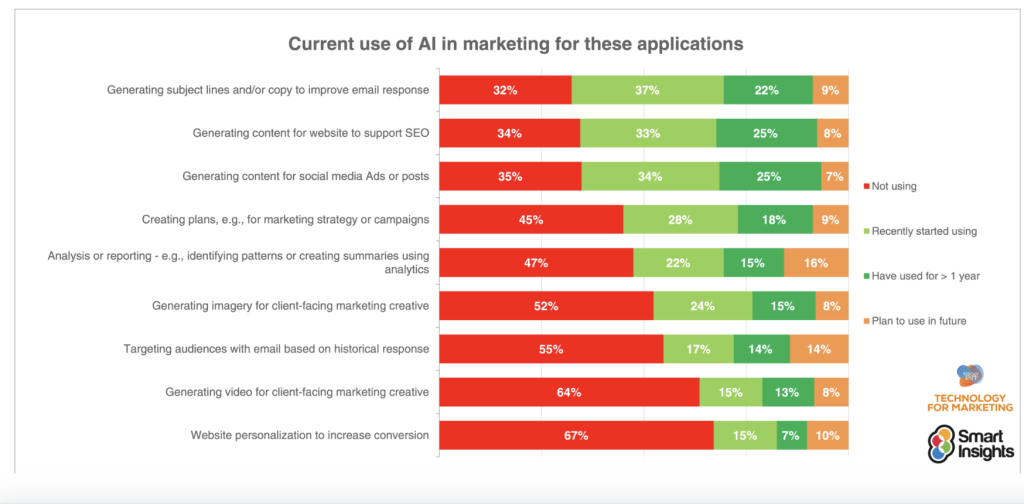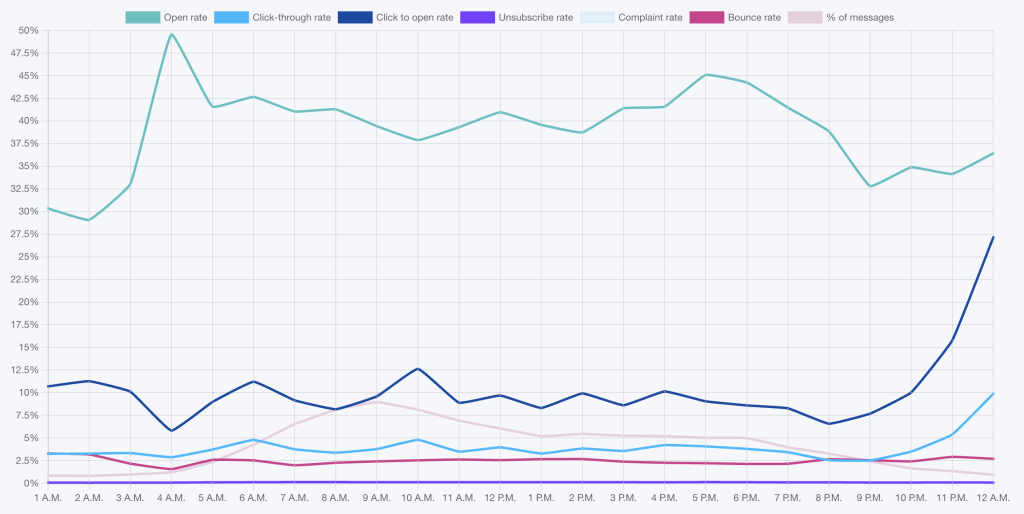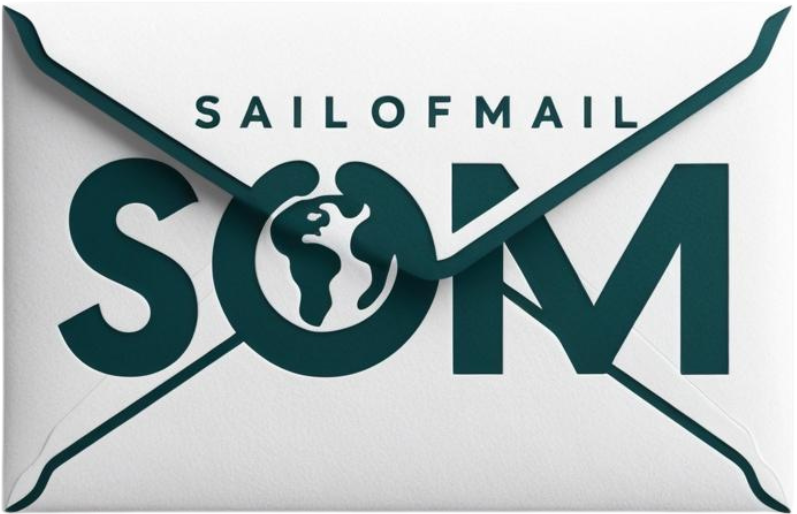How Technology is Revolutionising Email Marketing in 2025
How technology is revolutionising all kinds of marketing, including email marketing.
Even though there’s a lot of talk about AI in marketing, not every marketer uses it every day. The report of Smart Insight shows us with Technology for Marketing and eCommerce Expo, they found that about one in three marketers aren’t using AI for their usual work. Those who do use it mostly rely on AI to help write emails, improve search results, and create social media posts.

INTRODUCTION
Email marketing has always been one of the most powerful tools for businesses to reach their audience. In 2025, advancements in technology are making email marketing even better. New tools and systems are changing the way we create, send, and manage emails, helping businesses connect with customers like never before through effective email marketing.
More than half of people (51%) say that email marketing is the best way for brands to talk to them. Also, 95% of marketers say their email marketing helps them reach their business goals.
As technology continues to evolve, the potential for email marketing to drive engagement and sales will only increase, making it a crucial component of digital marketing strategies.
But making a good email marketing campaign isn’t easy. You need different skills and have to follow the latest trends. To make good marketing emails, you should:
- Personalise them based on what customers like and do
- Make sure they get into the right inboxes
- Get people to open and read them, so they help increase sales
LET’S DIVE DEEP INTO THIS.
72% of consumers say they now only engage with marketing messages tailored to their interests.
Technology Helps Personalise Emails
One of the biggest changes modern tools bring is personalisation. Instead of sending the same email to everyone, businesses can now send emails that feel personal. Advanced systems analyse data about customers, like their past purchases, browsing history, or even their location. Then, they help create emails that match their interests. For example, if someone buys running shoes, they might get an email about fitness gear or workout tips. This personalisation builds trust and encourages customers to stay engaged with the brand.
These tools also help segment email lists into smaller groups based on behaviour, demographics, or preferences. By targeting these specific segments, businesses can ensure their emails resonate more with each recipient.
Does adding personalised content in emails lead to higher engagement? This table shows how email engagement is linked to using personalisation in the email body.”

( https://c.smarterhq.com/resources/Privacy-Personalization-Report.pdf )
Personalising email content, not just subject lines, can boost open rates and reduce bounce rates. Emails with personalisation have an open rate of 44.30% compared to 39.13% for non-personalised emails, and a bounce rate of 2.26% compared to 2.50%. However, personalised emails tend to have lower click-through rates (3.18% vs. 4.45%) and click-to-open rates (7.19% vs. 11.36%), suggesting that while personalisation grabs attention, it doesn’t always encourage further interaction.
This shows that personalisation should be used carefully. Too much personalisation can be off-putting, and users are getting better at spotting automated messages. The key is to align your content with what your audience actually needs, rather than just focusing on adding more segments or dynamic content.
With the rise of AI and advanced content recommendations, email marketers can soon use real user data to make offers more relevant. This opens exciting possibilities for AI-driven, user-focused personalisation in email marketing.
Better Timing with Technology
Sending emails at the right time is important. New tools can predict when a person is most likely to check their inbox. This means emails are sent at the perfect time, increasing the chances of being opened. For example, some people check emails in the morning before work, while others might do it late at night. Systems use data like previous open times and time zones to figure this out, ensuring that the email lands at the top of the recipient’s inbox.
This feature is especially useful for businesses with global audiences, as these tools can account for different time zones and preferences automatically.
https://www.getresponse.com/resources/reports/email-marketing- benchmarks#time-frequency

This shows the average email marketing results based on the time, day, and how often emails are sent in campaigns.
Smarter Subject Lines
The subject line is the first thing people see. If it’s not interesting, they won’t open the email. Advanced tools help create subject lines that catch attention. They study what works and what doesn’t, using that information to suggest the best options. For instance, they might analyze millions of emails to identify patterns in successful subject lines, such as using numbers, emojis, or questions.
This saves marketers time and ensures that emails have a higher chance of being opened. Businesses can also A/B test subject lines, letting the system determine which one performs best.
Automation Made Easy
Modern tools make automation smarter. Businesses can set up email campaigns that work on their own. For example, if someone signs up for a newsletter, a welcome email can be sent right away. Then, more emails can follow based on the person’s actions, like clicking a link or making a purchase.
Automation can also create “drip campaigns,” where emails are sent over time to nurture leads or encourage repeat purchases. These campaigns can adapt in real-time based on how recipients interact with previous emails. For instance, if someone clicks on a discount offer but doesn’t buy, the system might send a reminder email with a bigger incentive.
Improved Analytics
New tools help businesses understand how their emails are performing. They analyse open rates, clicks, conversions, and other data to show what works and what needs improvement. This helps businesses make better decisions for future campaigns.
For example, analytics can identify which links in an email get the most clicks or what type of content keeps readers engaged. They can also predict trends, such as when engagement might drop, allowing businesses to adjust their strategies proactively.
Trends in 2025
In 2025, some exciting trends in email marketing include:
- Interactive Content: Emails with videos, polls, or quizzes to keep readers engaged. For example, a fashion brand might include a quiz to help customers find the perfect outfit.
- Integrated Chat Systems: Chat tools in emails to answer questions instantly or guide users to products they’re looking for. These tools can make the email experience more interactive and helpful.
- Predictive Analysis: Systems predict what products or services a customer might like next. For instance, an online bookstore could recommend books based on a customer’s reading history.
- Dynamic Content: Emails that update in real-time based on when they are opened. For example, showing the current weather or live countdowns for sales.
- Voice Integration: Emails optimised for voice assistants like Alexa or Google Assistant, making it easier for users to interact with them hands-free.
Challenges and Opportunities
While these advancements offer many benefits, there are challenges too. Businesses need to ensure they use technology ethically and respect customer privacy. Collecting and analysing data responsibly is crucial to maintaining trust. Transparency about how customer data is used can help address concerns and build stronger relationships.
On the other hand, the opportunities are immense. Small businesses can now compete with larger companies by using affordable tools. These advancements level the playing field, allowing businesses of all sizes to deliver high-quality email campaigns.
Conclusion
Technology is transforming email marketing, making it more personal, smarter, and easier to manage. Businesses can save time, reach more people, and see better results. By using modern tools, companies can create emails that truly resonate with their audience, leading to stronger customer relationships and increased sales.
As these tools continue to improve, email marketing will only get better. For businesses, it’s the perfect time to start using them in their email strategies. Embracing these changes now will set them up for success in the competitive digital landscape of 2025 and beyond.



Awesome email marketing article i loved it….